Type species: Neoris huttoni Moore, 1862.
A cold-tolerant genus of two-to-five 'species/taxa' endemic to the southern Central Asia, with one of the taxa penetrating westwards as far as Turkey. Closely related to Rinaca Walker (1855), Perisomena Walker (1855) and Saturnia Schrank (1802). Included in the latter by some authors, but treated as a valid genus by Rubinoff & Doorenweerd (2020).
Peigler (1996) studied a small sample of pinned specimens and believed that there were at least four species in the Neoris group, namely huttoni, shadulla, codyi and naessigi. However, considering the vast distances and high altitudes of the distributions of these moths, he 'expected' that up to a dozen species would ultimately be found to exist. Isolation by high mountains resulting in speciation is a well-known phenomenon in Saturniidae.
HOSTPLANT FAMILIES: Many trees and shrubs, but with a preference for the Rosaceae and Oleaceae.
UK: Hutton's Emperor Moth.
Neoris huttoni Moore, 1862, Trans. ent. Soc. Lond. (3)1: 321.(Taxonomic note. The various subspecies of Neoris huttoni given here are regarded by some authors as being specifically distinct, with subsp. galeropa listed as a subspecies of Neoris shadulla (see Nässig, Naumann & Löffler, 2017). They also list Neoris huttoni alatauica O. Bang-Haas, 1936 (synonym of Neoris shadulla Moore, 1872) and Neoris haraldi Schawerda, 1923 (synonym of Saturnia stoliczkana oliva A. Bang-Haas, 1910). However, they do admit that the systematic structure of Neoris is confusing, a problem compounded by moths in any given population being very variable in size and colour from year to year. All taxa are treated as refugial entities within one species in this work as per De Freina, 1992.
De Freina (1992) synonymized the following names under shadulla (Moore, 1872), namely stoliczkana (C. Felder & R. Felder, 1874), schencki (Staudinger, 1881), oliva A. Bang-Haas, 1910, and haraldi Schawerda, 1923. De Freina retained the poorly defined taxon galeropa (Püngeler, 1900) as a separate western subspecies (from Iran) allied to naessigi, which he described from eastern Turkey as new.)
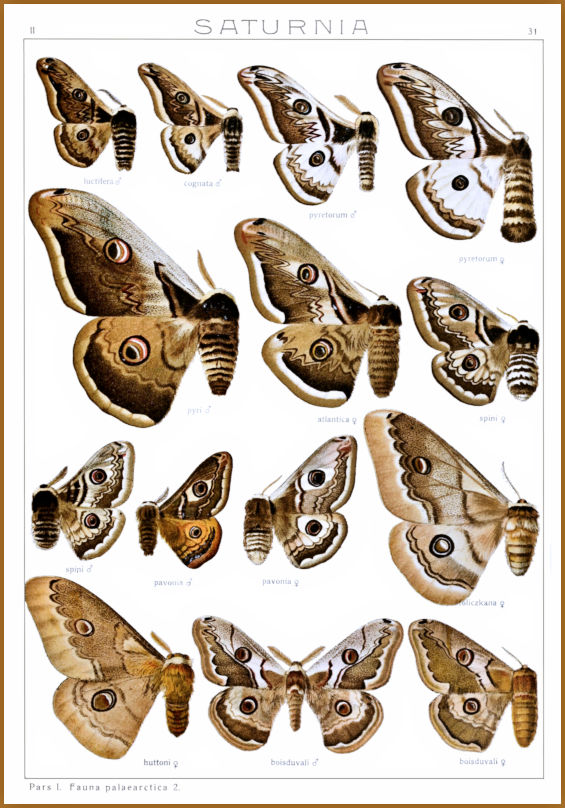
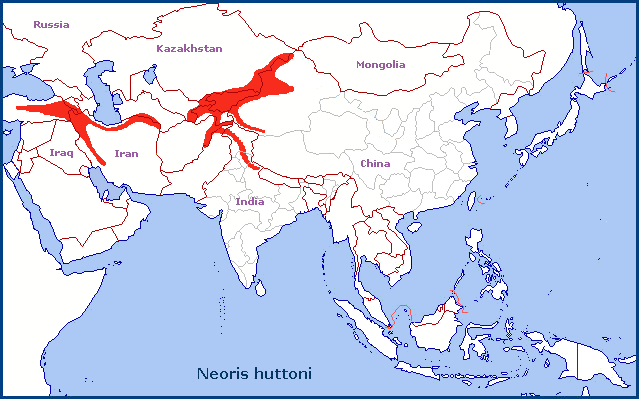
Type locality: 30Km SE Ovacik, upper Munzur Valley, Erzincan Province, Turkey.
Holarctic; western Palaearctic region: Monocentric -- Syrian refuge.
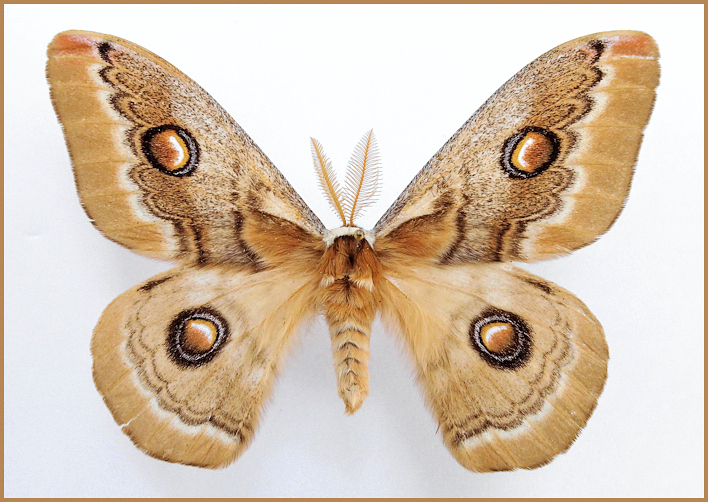
Wingspan 103--117mm. Superficially similar to Saturnia atlantica, but with a very distinct broad pale outer margin to the double postmedial band on all wings. On average larger than the other subspecies of Neoris huttoni, and often very brightly marked.
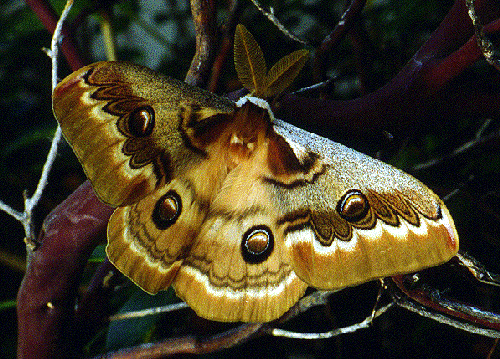
This nocturnal species inhabits river valleys with a good growth of riverine trees and shrubs, occurring at between 1200 and 1500m altitude.
Most adults emerge from mid- to late afternoon, with females calling that same night. Pairing takes place just after dark and lasts for only a few hours. Both males and females are readily attracted to light. A very cold tolerant species, readily flying in frosty weather.
Usually early October, with the entire population emerging within a few days of each other.
OVUM: Oblong, 2.6 x 1.6mm, olive-green with brown gum, and extremely hard. Laid in strings of up to ten on twigs, but only hatching the following spring with the onset of warmer weather. The overwintering stage.
LARVA: Full-fed 80mm. Monomorphic.
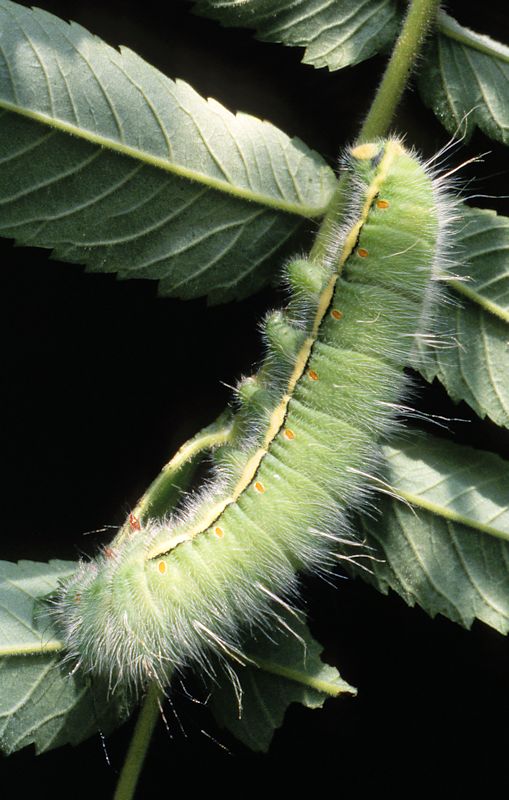
Full-grown larvae are basically pale green and covered with short to medium length silver hairs. Dorsally, each segment bears a pair of narrow hair tufts composed of a few long hairs -- those on the abdominal segments are silver, those on the thoracic segments black. The true legs and spiracles are orange, with the latter being surrounded by a yellow ring. There is a thick yellow subspiracular line on the abdominal segments (edged above with black), and a large spot of a similar yellow colour on each anal clasper.
The larvae are lethargic feeders from beneath leaves, resenting disturbance as well as rain. Descends to the ground to pupate among litter.
Hostplants. Mainly ashes (Fraxinus), but also found on pears (Pyrus), Prunus, quinces (Cydonia), spiraeas (Spiraea), Pistacia and willows (Salix). Can be reared on privets (Ligustrum) and sumacs (Rhus) in captivity, with large adults resulting from using bird cherry (Prunus padus) as a host.
PUPA: 30--35mm. Cylindrical, but tapering towards both ends. Uniform mahogany-brown with a yellowish patch between the eyes, and with a pair of hook clusters anally. Formed in a creamy-white to reddish-brown, semi-transparent, elongate, single-walled, unsealed cocoon among debris and leaves on the ground.
Unknown.
Known from a limited area of east-central Turkey, from the provinces of Erzincan, Erzurum, Hakkari, Tunceli and Sivas, and from Armenia (Karagyan, Kalashian, Ghrejyan & Danchenko, 2019) and western Azerbaijan (Zolotuhin, Didmanidze & Petrov, 2011). There is also a single record from the central Zagros Mountains of Iran (Naumann, Löffler & Nässig, 2017).
Extra-limital range. None.
Type locality: Mussoorie, Uttar Pradesh [Uttarakhand], northern India.
Holarctic; western Palaearctic region. Pleistocene refuge: Monocentric -- Sindian refuge.
Wingspan 80--95mm. Smaller, paler and less well marked than subsp. naessigi, although some individuals can be very reddish/brownish.
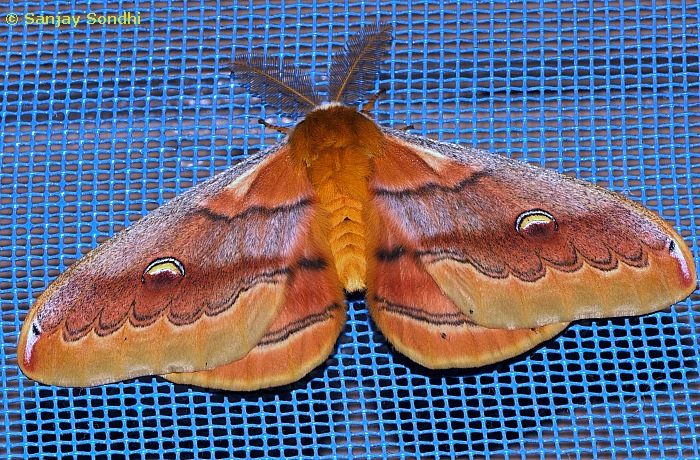
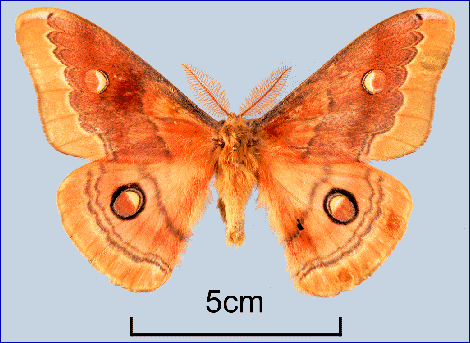
As per subsp. naessigi, but mainly at 1500--2100m altitude.
September and October, although odd individuals may turn up in late August.
OVUM: Oblong, 2.6 x 1.6mm, olive-green with brown gum, and extremely hard. Laid in strings of up to ten on twigs, but only hatching the following spring with the onset of warmer weather. The overwintering stage.
LARVA: Full-fed 80mm. Monomorphic.
Full-grown larvae are basically pale green and covered with short to medium length silver hairs. Dorsally, each segment bears a pair of narrow hair tufts composed of a few long hairs -- those on the abdominal segments are silver, those on the thoracic segments black. The true legs and spiracles are orange, with the latter being surrounded by a yellow ring. There is a thick yellow subspiracular line on the abdominal segments (edged above with black), and a large spot of a similar yellow colour on each anal clasper.
The larvae are lethargic feeders from beneath leaves, resenting disturbance as well as rain. Descends to the ground to pupate.
Hostplants. Found in April on wild species of pear (Pyrus) and apple (Malus). A minor pest of domestic apples in India.
PUPA: 30--35mm. Cylindrical, but tapering towards both ends. Uniform mahogany-brown with a yellowish patch between the eyes, and with a pair of hook clusters anally. Formed in a creamy-white to reddish-brown, semi-transparent, elongate, single-walled, unsealed cocoon among debris and leaves on the ground.
Unknown.
The Himalayan foothills of northwest India, from Uttarakhand (Mussoorie, Dehradun (Atkinson, 1884)) west to Jammu and Kashmir and, maybe, Azad Kashmir (Pakistan) (Naumann, Löffler & Nässig, 2017).
Extra-limital range. None.
Type locality: Kopet-Dagh near Aschabad [Kopet Dag near Ashkhabad, Turkmenistan].
Holarctic; western Palaearctic region. Pleistocene refuge: Monocentric -- Iranian refuge.
Wingspan 85--133mm. Usually smaller and paler but similar to subsp. naessigi, and just as variable in colour and size.
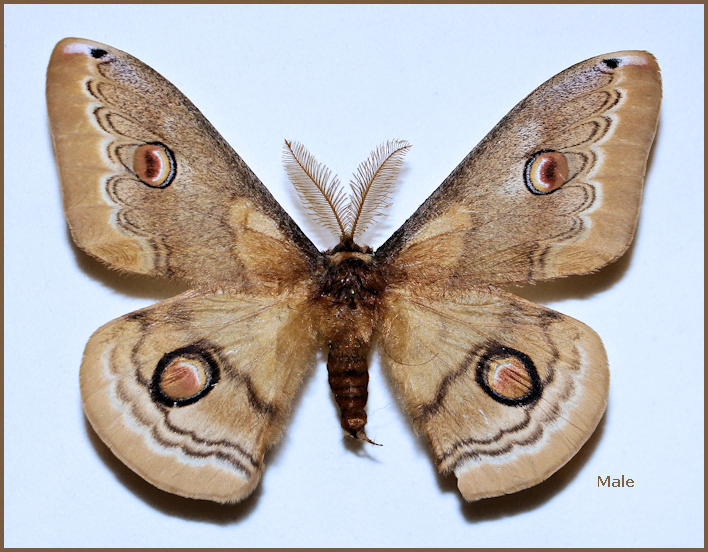
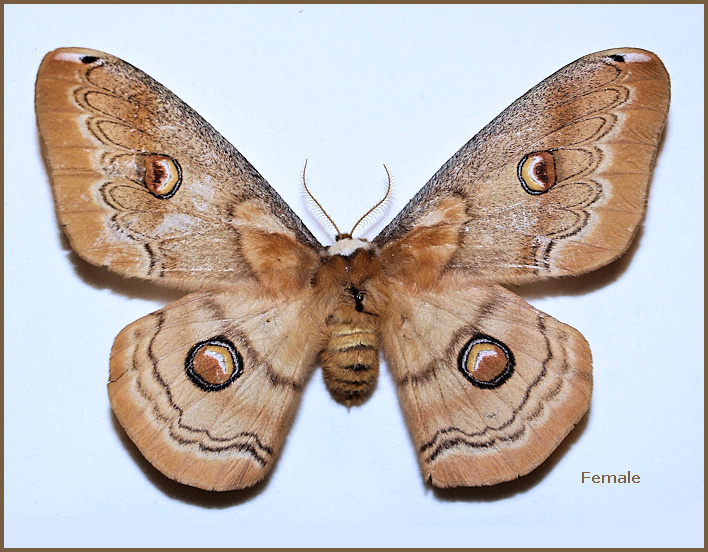
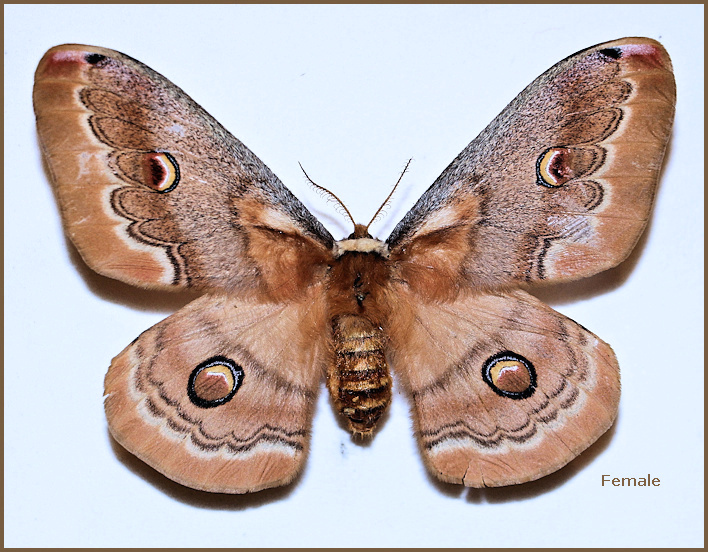
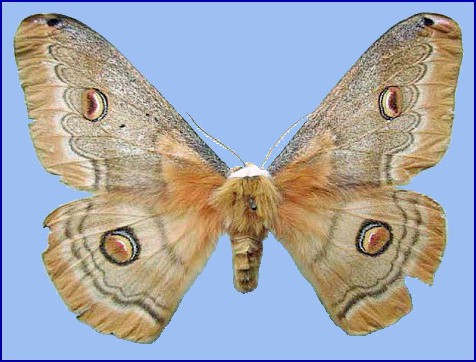
As per subsp. naessigi.
Late September and October.
OVUM: Oblong, 2.6 x 1.6mm, olive-green with brown gum, and extremely hard. Laid in strings of up to ten on twigs, but only hatching the following spring with the onset of warmer weather. The overwintering stage.
LARVA: Full-fed 80mm. Monomorphic.
Full-grown larvae are basically pale green and covered with short to medium length silver hairs. Dorsally, each segment bears a pair of narrow hair tufts composed of a few long hairs -- those on the abdominal segments are silver, those on the thoracic segments black. The true legs and spiracles are orange, with the latter being surrounded by a yellow ring. There is a thick yellow subspiracular line on the abdominal segments (edged above with black), and a large spot of a similar yellow colour on each anal clasper.
The larvae are lethargic feeders from beneath leaves, resenting disturbance as well as rain. Descends to the ground to pupate.
Hostplants. Depending on altitude, found from April until August on wild species of Rosaceae.
PUPA: 30--35mm. Cylindrical, but tapering towards both ends. Uniform mahogany-brown with a yellowish patch between the eyes, and with a pair of hook clusters anally. Formed in a creamy-white to reddish-brown, semi-transparent, elongate, single-walled, unsealed cocoon among debris and leaves on the ground.
Unknown.
From eastern Armenia and the Alborz Mountains (Atman7, iNaturalist 2021) of northern Iran eastwards to the Kopet Dag straddling Iran and Turkmenistan (Naumann, Löffler & Nässig, 2017).
Extra-limital range. None.
Type locality: Shadulla, Yarkand River, East Turkestan [Xaidulla, Karakax River, Xinjiang Province, China].
Holarctic; western Palaearctic region. Pleistocene refuge: Monocentric -- Turkestan refuge.
Wingspan 80--95mm. Smaller, paler and less well marked than subsp. naessigi.
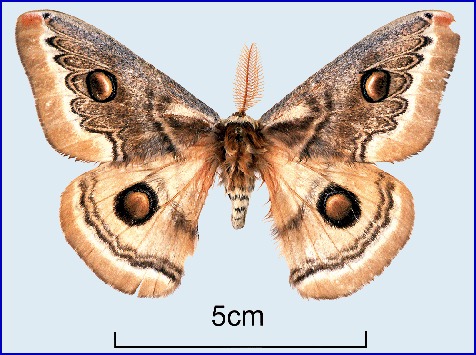
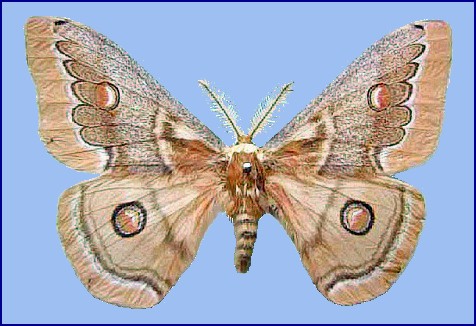
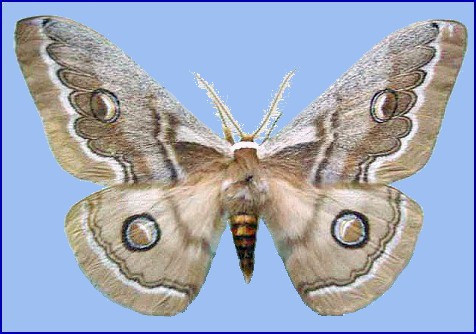
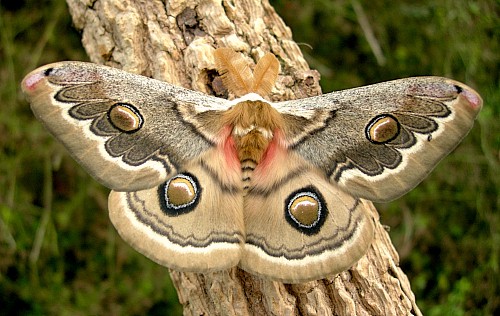
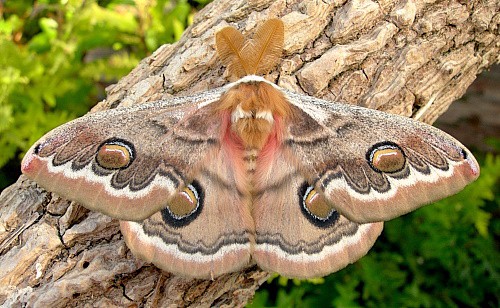
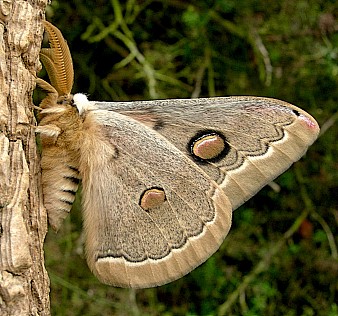
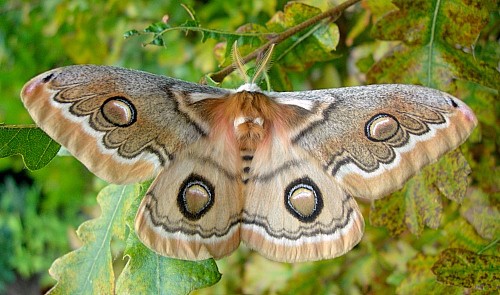
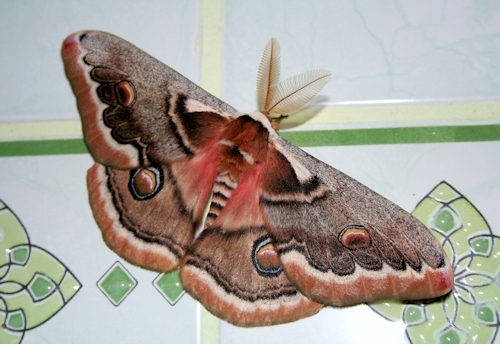
As per subsp. naessigi, but from 1100 to 3200m altitude. The adults emerge in the late afternoon and generally pair that same night well after dark. This is a brief affair, with females then proceeding to lay almost all their eggs before dawn.
Resting moths are very skittish and will drop to the ground at the slightest provocation before warming up and flying off to some nearby bush. Here they will rest with their wings either closed over their backs or held slightly open. The nocturnal flight is very fast and vigourous. Moths are very cold-resistant and in Central Asia can be seen flying in falling snow (Zolotuhin, Didmanidze & Petrov, 2011)
A short-lived species, rarely surviving more that 3 days. Females generally die within 24 hours of laying their eggs.
Late September and October; however, in some years some populations may emerge as early as mid September.
OVUM: Oblong, 2.6 x 1.6mm, olive-green with brown gum, and extremely hard and glossy. Laid in neat strings of up to 15 on twigs, but only hatching the following spring with the onset of warmer weather. The overwintering stage.
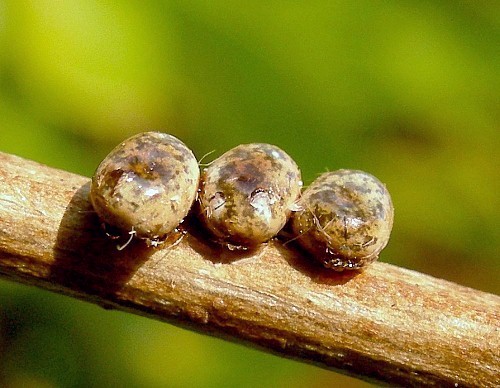
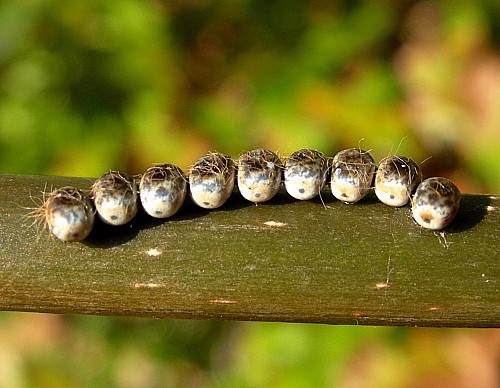
LARVA: Full-fed 80mm. Monomorphic.
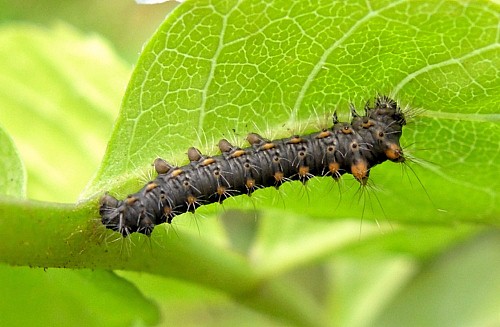
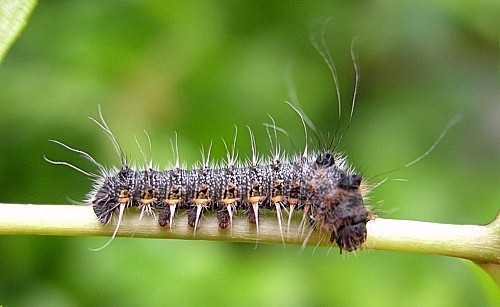
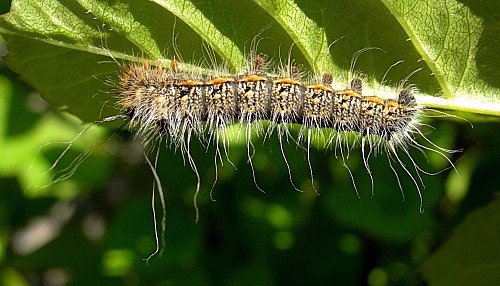
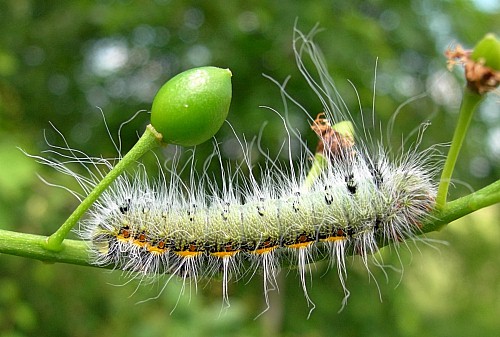
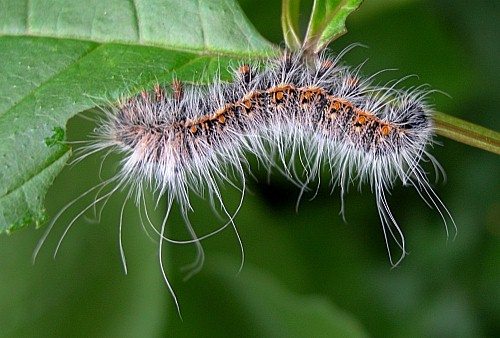
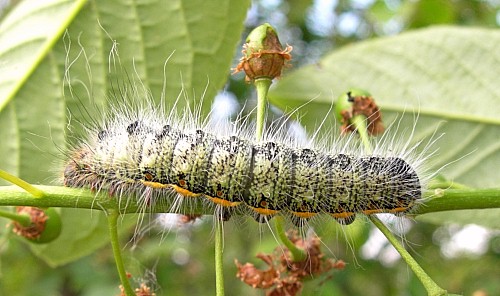
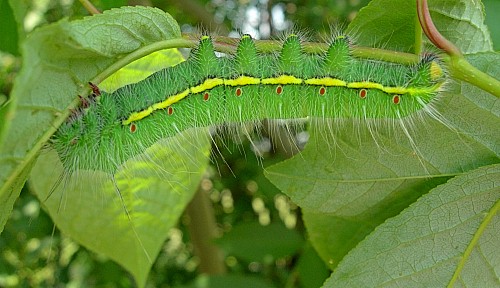

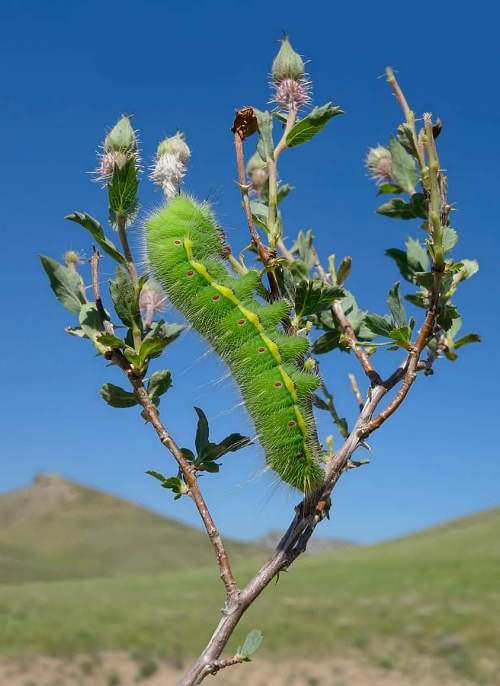
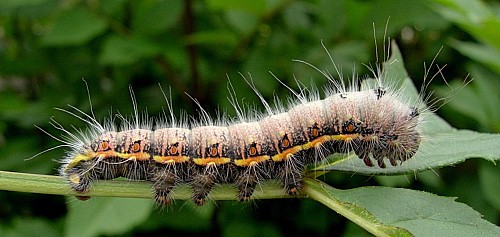
Full-grown larvae are either green or greyish-brown and covered with short to medium length silver hairs. Dorsally, each segment bears a pair of narrow hair tufts composed of a few long hairs -- those on the abdominal segments are silver, those on the thoracic segments black. The true legs and spiracles are orange, with the latter being surrounded by a yellow ring. There is a thick yellow (or yellow-orange) subspiracular line on the abdominal segments (edged above and below with black), and a large spot of a similar yellow colour on each anal clasper.
The larvae are lethargic feeders from beneath leaves, resenting disturbance as well as rain. Descends to the ground to pupate.
Hostplants. Depending on altitude, found from April until August on wild species of spiraea (Spiraea), rose (Rosa) and pear (Pyrus), as well as other Rosaceae. Even Elaeagnus angustifolia and Tamarix has been noted. Zolotuhin, Didmanidze & Petrov, (2011) state that larvae can be common in Central Asia on Malus, Prunus, Crataegus and Acer. In Uzbekistan it has also been found on Pistacia, almonds (Prunus dulcis) and Ulmus minor, where it can become a minor pest of shelter belts containing these (Alimdzhanov, 1966; Alekseitsev & Tuzov, 1984). A major pest of Populus euphratica in Xinjiang, China, a tree which is used extensively in shelter belts, wind breaks and to stabilize river banks (He, Wang & Chen, 2017).
[In captivity will feed on ashes (Fraxinus spp.) and smooth-leaved osiers (Salix spp.), but prefers various species of cherry, particularly Prunus padus.]
PUPA: 30--35mm. Cylindrical, but tapering towards both ends. Uniform mahogany-brown with a yellowish patch between the eyes, and with a pair of hook clusters anally. Formed in a creamy-white to reddish-brown, semi-transparent, elongate, single-walled, unsealed cocoon among debris and leaves on the ground.
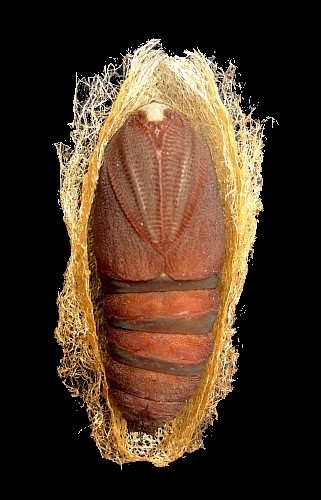
Unknown.
A subspecies of the mountain chains which separate the western and eastern Palaearctic regions, from Ladakh to the southern Altai. This encompasses Ladakh (India), Azad Kashmir (Pakistan), eastern Afghanistan (Wiltshire, 1961; Rougeot, 1969; Naumann, Löffler & Nässig, 2017), western Xinjiang Province (China) (Kemal & Koçak, 2018c), Tajikistan, eastern Uzbekistan (Toropov, Milko, Zhdanko & Evdoshenko, 2023), Kyrgyzstan (Toropov, Milko, Zhdanko & Evdoshenko, 2023), eastern Kazakhstan (Toropov, Milko, Zhdanko & Evdoshenko, 2023), and the Altai Mountains of China, where it meets the very similar eastern palaearctic Rinaca boisduvali (Eversmann, 1846).
[Note: The records of this species from the northern Altai, the Krasnoyarsk area, and the eastern Sajan Mountains (Russia), as well as from the provinces of eastern Xinjiang, Gansu and Shaanxi, China (Zhu & Wang, 1983; Kereman et al., 2009), seem to be the result of misidentifications (Naumann, Löffler & Nässig, 2017). Some of these records may be of Rinaca boisduvali, which is now known to occur as far west as the Altai Mountains.]
None; however, see taxonomic note above.
 Return to species list
Return to species list